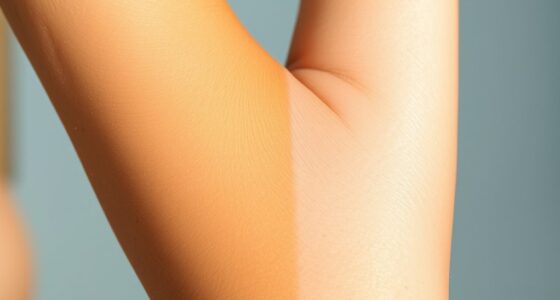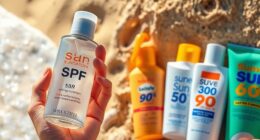Breaking stereotypes around tanning and masculinity means recognizing that traditional ideas linking a tan to confidence or strength are outdated. Today, many men are embracing grooming, self-care, and diverse body images that challenge these norms. Media influences are shifting, highlighting healthier, safer ways to look good without risking health. If you want to explore how redefining masculinity promotes confidence and well-being, keep exploring this important topic.
Key Takeaways
- Challenging stereotypes by promoting diverse representations of masculinity that do not rely on tanning or muscular ideals.
- Highlighting health risks of tanning to counteract the association of a tanned look with confidence and vitality.
- Encouraging self-care and grooming practices that focus on health and well-being instead of tanning for appearance.
- Using media and social influencers to normalize natural skin tones and reduce the link between masculinity and tanned skin.
- Educating men on safe alternatives like sunless tanning to achieve aesthetic goals without compromising health.
Challenging Traditional Views of Masculine Appearance
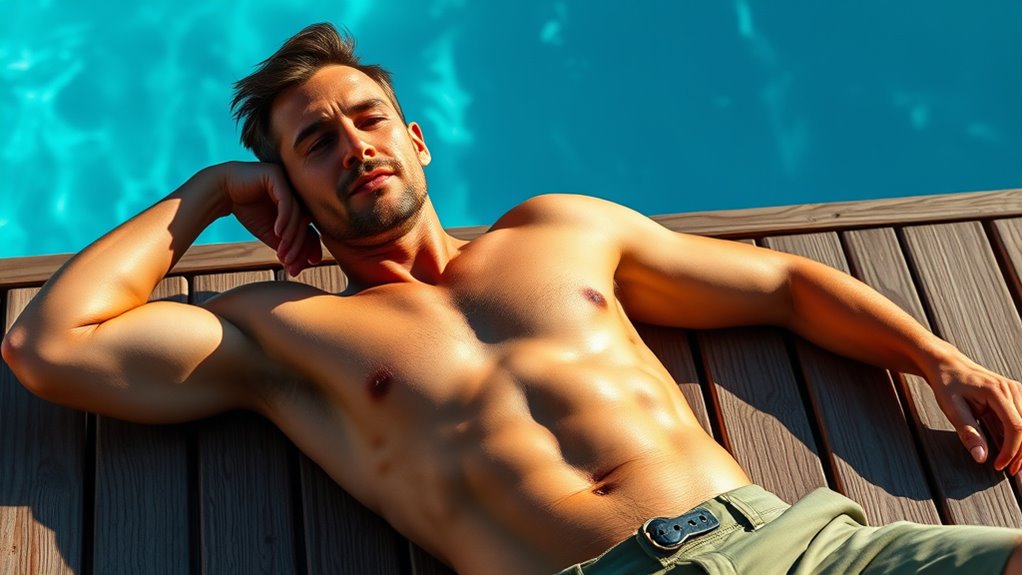
Have you ever wondered why society has so rigid ideas about what a man should look like? Traditional masculinity emphasizes physical strength, ruggedness, and muscularity, often linked to dominance and status. Media portrayals reinforce these stereotypes, showing men as tall, broad-shouldered, and physically fit. These standards influence what society perceives as a “masculine” appearance, shaping men’s self-image and behavior. Additionally, embracing diverse representations can foster a more inclusive understanding of masculinity. Modern times challenge these narrow ideals, especially as body image diversity gains recognition and acceptance. More people recognize that masculinity can be diverse, including different body types and styles. Cultural norms vary widely, and globalization promotes a broader understanding of masculine beauty. By questioning traditional standards, men are free to express themselves beyond physical strength, breaking free from stereotypes that have long dictated how a man should look. Recognizing the importance of positive body image can further help dismantle harmful stereotypes. Research indicates that promoting body positivity can significantly improve mental health and self-esteem among men. Furthermore, campaigns that highlight diverse male role models help challenge the stereotypes perpetuated by mainstream media.
The Rise of Grooming and Self-Care in Men

In recent years, men’s grooming and self-care have experienced a remarkable surge, transforming how masculinity is expressed and perceived. You’re likely noticing more products tailored specifically for men, with the market projected to reach over USD 376 billion globally by 2030. Younger men are leading this shift, spending more on skincare, grooming devices, and eco-friendly products. Many now see grooming as a way to boost confidence, not just vanity. Retailers and brands are expanding men’s sections, offering personalized and premium options, often endorsed by celebrities. The rise of grooming salons and online platforms makes self-care more accessible. Society increasingly links grooming to wellness and self-expression, breaking down stereotypes and redefining modern masculinity. According to Vetted – HARTSBURG NEWS, the growth of grooming and self-care in men is supported by evolving perceptions of health and wellness. Additionally, the normalization of men’s self-care routines is helping to challenge traditional gender norms and promote broader acceptance. As the industry incorporates modern grooming trends, it also emphasizes sustainable and eco-friendly practices, aligning with the values of a conscious consumer base. Furthermore, incorporating elements of personal grooming rituals, such as skincare and hygiene routines, can enhance overall well-being and confidence.
Cultural Shifts: From Vanity to Confidence

Cultural attitudes toward tanning have shifted dramatically over time, transforming it from a sign of social lower status into a symbol of health, luxury, and confidence. Today, a tan is often associated with vitality and active lifestyles, especially in Western cultures. This change reflects broader social and economic shifts, where leisure time and wealth make tanning more accessible and desirable. While some cultures still value fairness, many now see a tan as a sign of self-care and success. Growing health awareness has also led to reevaluating tanning practices, with a move toward safer methods like sunless tanning. Additionally, the rise of self-care trends has helped redefine tanning as an aspect of personal wellness rather than superficial vanity. The increasing popularity of outdoor recreation demonstrates how a tan can also symbolize an active and engaged lifestyle. As societal perceptions continue to evolve, tanning is increasingly viewed not just as a beauty choice but as a reflection of modern masculinity, emphasizing health and confidence over traditional stereotypes. Furthermore, the shift towards healthy lifestyle choices underscores how a tan now often signifies vitality and well-being rather than superficial appearance. Ultimately, this cultural evolution highlights how perceptions of beauty and masculinity adapt, positioning tanning as a confidence booster rather than vanity.
The Influence of Media and Industry on Male Beauty Standards
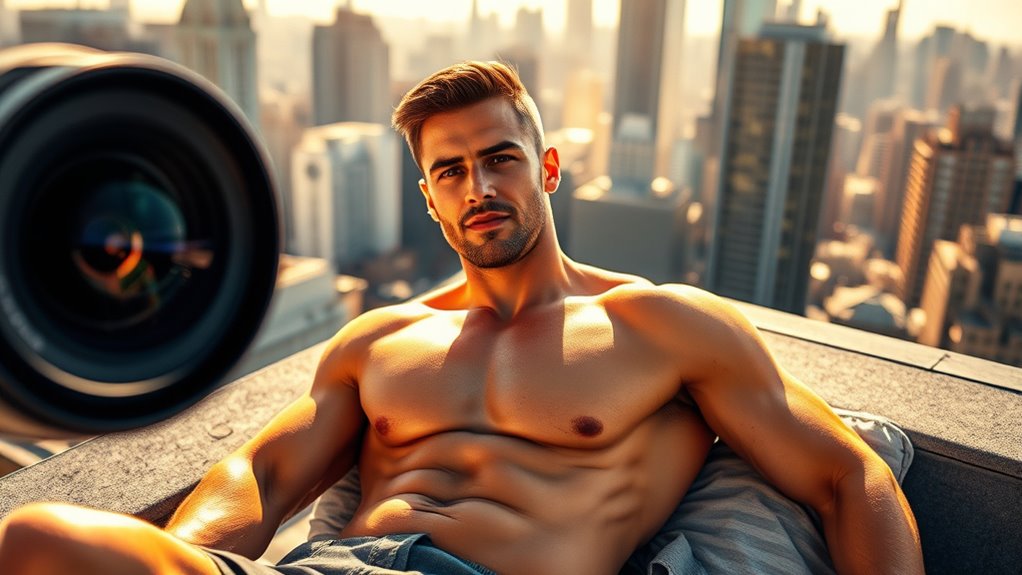
Media and industry play a powerful role in shaping modern male beauty standards by actively promoting specific body ideals, particularly the lean, muscular physique associated with strength and masculinity. You’re exposed to images that emphasize broad shoulders, narrow waists, and athletic builds, often making moderately muscular bodies seem less impressive. Western media links muscularity with high status and traditional masculinity, especially through sports, action movies, and news programs. On social media, you’re influenced by images that reinforce these standards, which can lead to dissatisfaction with your own body. The fitness and fashion industries capitalize on this by marketing products that promise to help you achieve the ideal look. Tanning industries also target men, suggesting that a darker, masculine skin tone enhances attractiveness and confidence. Both 16PF and MBTI assessments reveal how societal influences can shape perceptions of masculinity and personal identity. Additionally, the influence of media encourages the use of tanning as a way to project confidence and enhance perceived masculinity, further reinforcing these stereotypes. Recognizing the impact of media portrayals on body image can empower men to challenge unrealistic standards and embrace diverse expressions of masculinity. Cultural trends and consumer marketing strategies often emphasize a specific masculine image, which may not reflect the diversity of real male identities. Furthermore, advancements in AI security technologies suggest that media content could soon be monitored to promote healthier and more inclusive representations of masculinity.
Understanding the Risks Behind Tanning Behaviors

Tanning behaviors may seem harmless or even beneficial for boosting confidence and achieving a desired look, but they come with serious health risks. UV radiation from both sunlight and tanning beds is a known carcinogen, increasing your chances of developing skin cancer. Indoor tanning exposes you to UVA and UVB rays, which can be as strong as or stronger than natural sunlight, profoundly raising melanoma risk—especially if you start young. Tanning beds raise your odds of squamous cell carcinoma by 58% and basal cell carcinoma by 24%. In the U.S., over 419,000 skin cancer cases annually are linked to indoor tanning, with young women most affected. Many believe tanning is safe or protective, but it’s a dangerous misconception that can lead to lifelong health consequences. Understanding the risks behind tanning behaviors is crucial for making informed health choices, especially considering that proper planning can help mitigate some health-related uncertainties. Recognizing that UV exposure is a carcinogen underscores the importance of early detection for skin cancer, which can significantly improve treatment outcomes. Additionally, many individuals underestimate the influence of unrepentant cheater strategies, which can affect their ability to make health decisions based on honest information and support.
Rethinking Masculinity and Body Image Norms

Understanding and challenging traditional notions of masculinity is essential for reshaping how you perceive your body. Cultural ideals often emphasize muscularity, athleticism, and strength as markers of manliness, which can pressure you to conform. Internalizing these norms influences your attitudes toward body change, sometimes leading to dissatisfaction or unhealthy behaviors like extreme dieting or steroid use. Media portrayals and social comparisons intensify these pressures, especially during adolescence and college years. You might see yourself as less masculine if you don’t meet these standards, yet you also tend to self-enhance when you align with the ideal. Recognizing that masculinity is socially constructed allows you to question narrow norms and develop a healthier, more inclusive view of your body—one rooted in self-acceptance rather than stereotypes. Additionally, understanding the safety of electric heated mattress pads can be a reminder to prioritize safety and well-being in all aspects of your life, including body image and self-care. Being aware of broader financial literacy concepts, such as credit card terms and responsible payment processing, can also empower you to make informed decisions that support your overall well-being.
Promoting Safe and Healthy Alternatives to Tanning
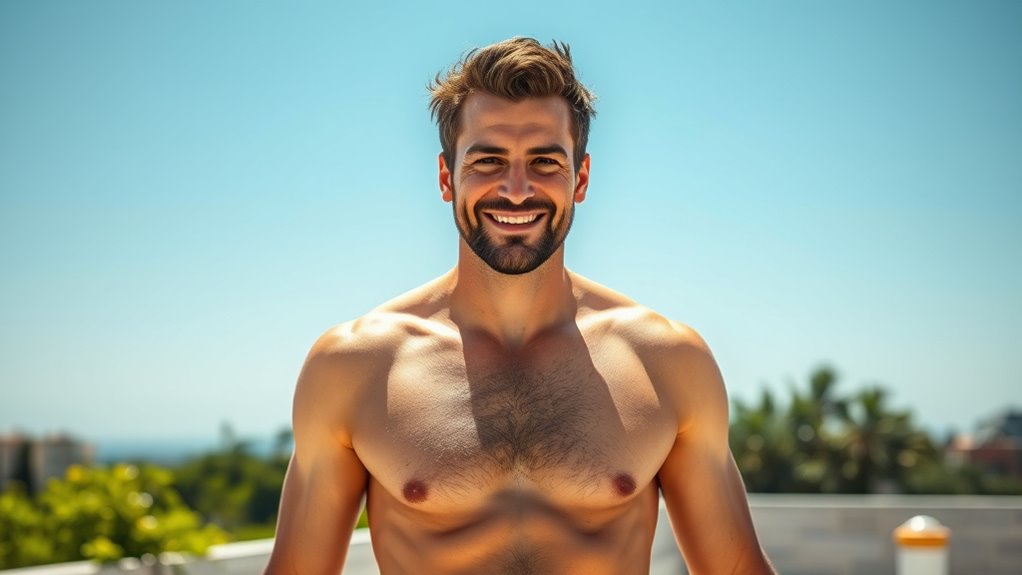
Opting for safe and healthy alternatives to traditional tanning can help you achieve a bronzed look without exposing your skin to harmful UV rays. Sunless products like self-tanners use DHA, an FDA-approved compound that creates a temporary tan by reacting with skin amino acids. Spray tans offer an even, long-lasting glow after a quick session, especially when combined with exfoliation beforehand and moisturizing afterward. Bronzing drops and tinted moisturizers provide instant, subtle color boosts with added skincare benefits like hydration and antioxidants. Gradual tanning lotions build color gradually, keeping your skin nourished. Temporary makeup options like bronzing powders, tinted oils, and shimmer creams give you a quick, washable glow. These alternatives help you enjoy a tanned appearance while reducing health risks and breaking stereotypes about masculinity and tanning.
Building Awareness and Changing Public Perceptions
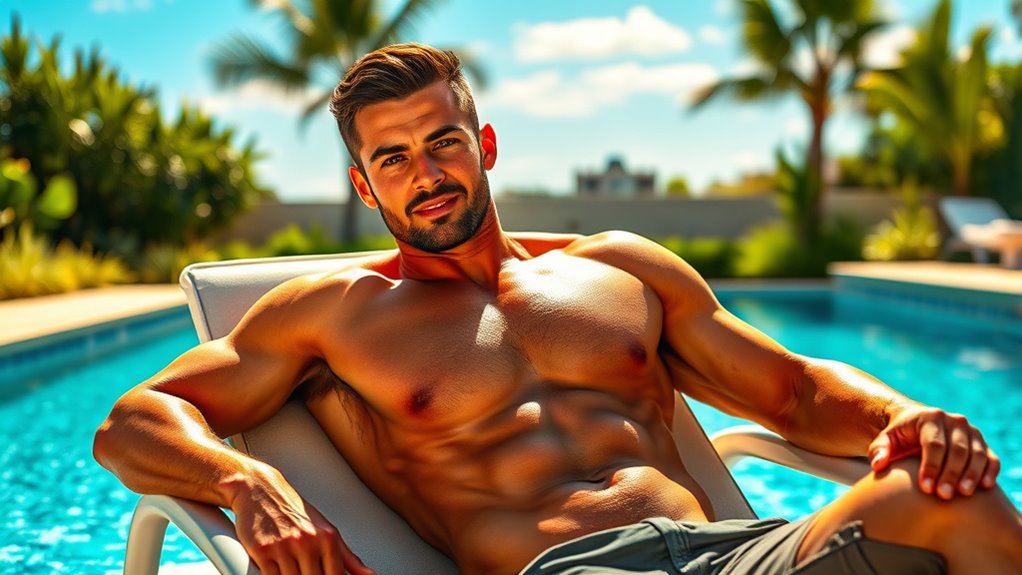
Changing how people perceive tanning requires raising awareness about its risks and reshaping societal attitudes, especially among men. You need to challenge the stereotype that tanning is just a female activity by highlighting that one in three indoor tanners in the U.S. are men, many of whom engage in riskier behaviors like smoking and binge drinking. Address men’s higher dependency on tanning beds and the lack of targeted messaging that speaks directly to them. Use social media influencers to promote safe tanning practices and body-positive attitudes. Educate about addiction risks and the long-term health consequences, such as melanoma. By shifting the narrative and emphasizing masculinity’s connection to health-conscious grooming, you can foster a more inclusive understanding that tanning isn’t a measure of confidence or attractiveness.
Frequently Asked Questions
How Do Cultural Stereotypes Influence Men’S Grooming and Tanning Habits?
Cultural stereotypes shape how you view grooming and tanning. You might feel pressured to avoid appearing feminine, so you skip self-care routines or tanning. If you’re part of the LGBTQ+ community, you may face different standards, encouraging meticulous grooming or makeup use. Society’s evolving views now see grooming as self-care, but traditional norms still influence your habits, sometimes leading to risky behaviors like excessive tanning or neglecting skin protection.
What Role Does Peer Pressure Play in Male Tanning Behaviors?
Peer pressure acts like a puppeteer pulling your strings, guiding your tanning choices. When friends promote tanning as a social norm or bonding activity, you’re more likely to follow suit to fit in. Social cues, encouragement, and peer validation shape your perceptions of attractiveness and masculinity. To resist this influence, recognize peer norms and focus on your own health and identity, breaking free from the invisible strings of peer-driven tanning pressures.
Are There Specific Health Risks for Men From Indoor Tanning Compared to Women?
You might wonder if men face unique health risks from indoor tanning compared to women. Research shows that, biologically, UV radiation increases skin cancer risks equally for all genders, including melanoma and non-melanoma types. However, men tend to be less aware of these risks and engage less in sun protection. This lower awareness and protective behavior heighten their vulnerability, making indoor tanning particularly risky for men, despite similar biological susceptibility.
How Can Public Health Campaigns Better Target Men Who Tan?
You need to hit the nail on the head by crafting campaigns that speak directly to men who tan. Use social media influencers they trust, highlight health risks, and challenge stereotypes linking tanning to masculinity. Focus on positive messages that frame health responsibility as strength, not weakness. By making the message relatable and urgent, you’ll better motivate men to reconsider their tanning habits and protect their health.
What Are Effective Ways to Promote Natural Skin Confidence Among Men?
You can promote natural skin confidence among men by encouraging healthy skincare routines and educating them on product choices suited to their skin types. Highlight natural skincare options and emphasize self-care as part of their daily routine. Use positive media portrayals of diverse skin types to challenge stereotypes, and offer support through resources and community engagement. Helping men accept their aging and skin conditions builds lasting confidence rooted in self-acceptance.
Conclusion
By challenging outdated notions of masculinity, you can embrace healthier self-care routines that defy Victorian-era stereotypes. Recognize that confidence comes from authenticity, not a fake tan or superficial appearance. As society shifts, it’s essential to prioritize safe choices over fleeting trends, much like the Enlightenment’s pursuit of reason. By doing so, you help reshape perceptions, proving that true strength lies in self-acceptance and rejecting harmful stereotypes—an act as revolutionary as any in history.


